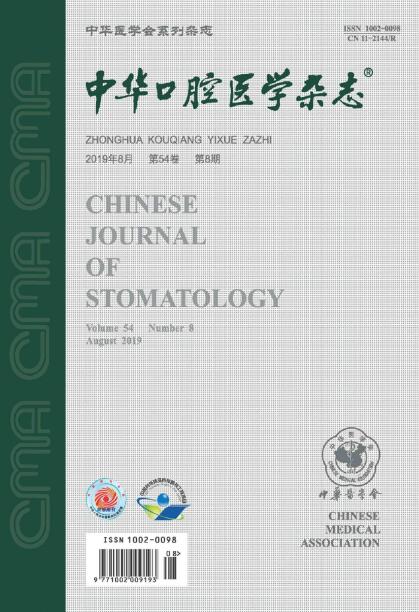[牙龈卟啉单胞菌诱导血管内皮细胞铁下垂的作用及机制研究]。
摘要
目的:探讨牙龈卟啉单胞菌(Porphyromonas gingivalis, Pg)是否会诱导血管内皮细胞铁下垂并预测Hub基因的表达。方法:首先用Pg (W83)刺激人脐静脉内皮细胞(HUVEC) 4 h,透射电镜观察其凋亡相关形态学特征。随后,从Pg刺激前后的HUVEC中提取RNA进行转录组测序(RNA-seq)。进行富集分析以确定差异表达基因(DEG)是否与铁下垂有关。鉴定出与凋亡相关的DEG (fe -DEG),然后进行基因本体(GO)功能注释、京都基因与基因组百科全书(KEGG)途径富集分析、蛋白-蛋白相互作用(PPI)网络构建和Hub基因预测。接下来,根据RNA-seq结果,用脂多糖(LPS)刺激HUVEC 24小时。检测已建立的铁下垂标志物。检测指标及方法:细胞计数试剂盒-8测定细胞存活率;DCFH-DA探针检测活性氧(ROS);Fe 2 +、脂质过氧化物(LPO)、丙二醛(MDA)、还原性/氧化性谷胱甘肽比值(GSH/GSSG)(商用试剂盒);JC-1探针检测线粒体膜电位(MMP);Western blotting (WB)和实时荧光定量PCR (RT-qPCR)检测溶质载体家族7成员11 (SLC7A11)、溶质载体家族3成员2 (SLC3A2)和谷胱甘肽过氧化物酶4 (GPX4)的表达。最后,采用RT-qPCR验证LPS刺激24 h后HUVEC中预测的Hub基因的表达,包括肿瘤坏死因子(TNF)或TNF-α、白细胞介素(IL)-6和前列腺素内过氧化物合成酶2 (PTGS2)。结果:pg刺激的HUVEC细胞线粒体大小减小,嵴丢失。pg感染组与对照组之间HUVEC的DEG在铁下垂途径中富集,从中鉴定出56个fe -DEG。GO分析显示在TNF、LPS、生物刺激等响应中富集,KEGG分析显示在TNF、c型凝集素受体、IL-17信号通路等中富集。在56个基因的PPI网络中,TNF、IL-6和PTGS2被预测为Hub基因,这些基因与凋亡相关的途径,包括不饱和脂肪酸生物合成和ROS代谢过程调控显著相关。与对照组[(100.00±1.44)%]相比,LPS显著降低HUVEC活力[(66.77±1.80)%],而fe -1可改善HUVEC活力[(84.50±1.47)%](P0.05)。LPS组ROS荧光强度(1 523.00±250.70)显著高于对照组(328.20±38.68)或LPS+Fer-1组(753.30±67.11)(均P0.05)。LPS组Fe +、LPO和MDA水平[分别为(29.83±4.25)μmol/106、(3.58±0.24)μmol/gprot、(5.54±0.33)μmol/gprot]显著高于对照组[(7.29±0.79)μmol/gprot、(1.08±0.05)μmol/gprot、(2.06±0.17)μmol/gprot]和LPS+Fer-1组[(16.33±1.63)μmol/106、(2.01±0.09)μmol/gprot、(3.24±0.26)μmol/gprot]。LPS组GSH/GSSG比值(2.17±0.08)显著低于对照组(6.96±0.20)和LPS+ fe -1组(4.31±0.81)(均p < 0.05)。LPS组JC-1聚集体/单体荧光强度比(0.46±0.07)明显低于对照组(285.60±160.40),而fe -1预处理(1.53±0.17)明显减轻了这种下降(均P0.05)。LPS组SLC7A11、SLC3A2、GPX4蛋白和mRNA表达量均显著低于对照组和fer1 +LPS组(P0.05)。LPS组TNF、IL-6、PTGS2 mRNA表达量较对照组显著上调,且LPS+Fer-1组这3个因子的表达量显著低于LPS组(均P0.05)。结论:Pg驱动血管内皮细胞铁下垂,TNF、IL-6和PTGS2被认为是这一过程中潜在的新型枢纽基因。Objective: To investigate whether Porphyromonas gingivalis (Pg) induces ferroptosis in vascular endothelial cells and predict the Hub genes. Methods: Firstly, human umbilical vein endothelial cells (HUVEC) were stimulated with Pg (W83) for 4 h, and transmission electron microscopy was used to observe ferroptosis-related morphological characteristics. Subsequently, RNA was extracted from HUVEC before and after Pg stimulation for transcriptome sequencing (RNA-seq). Enrichment analysis was performed to determine if differentially expressed genes (DEG) associated with ferroptosis. Ferroptosis-related DEG (Fer-DEG) were identified and then underwent gene ontology (GO) functional annotation, Kyoto Encyclopedia of Genes and Genomes (KEGG) pathway enrichment analysis, protein-protein interaction (PPI) network construction, and Hub gene prediction. Next, based on RNA-seq results, HUVEC were stimulated with lipopolysaccharide (LPS) for 24 h. Established ferroptosis markers were detected. The indices and detection methods were as follows: cell viability via cell counting kit-8; reactive oxygen species (ROS) by the DCFH-DA probe; Fe²⁺, lipid peroxides (LPO), malondialdehyde (MDA), and reduced/oxidized glutathione ratio (GSH/GSSG) with commercial kits; mitochondrial membrane potential (MMP) using the JC-1 probe; solute carrier family 7 member 11 (SLC7A11), solute carrier family 3 member 2 (SLC3A2), and glutathione peroxidase 4 (GPX4) expressions by Western blotting (WB) and real-time fluorescence quantitative PCR (RT-qPCR). Finally, RT-qPCR was used to validate the expression of predicted Hub genes in HUVEC after 24 h LPS stimulation, including tumor necrosis factor (TNF) or TNF-α, interleukin (IL)-6, and prostaglandin-endoperoxide synthase 2 (PTGS2). Results: The mitochondria exhibited size reduction and cristae loss in Pg-stimulated HUVEC. DEG of HUVEC between the Pg-infected and control groups were enriched in the pathway of ferroptosis, and from which 56 Fer-DEG were identified. GO analysis showed enrichment in in responses to TNF, LPS, biotic stimulus, etc. and KEGG analysis revealed enrichment in TNF, C-type lectin receptor, and IL-17 signaling pathways, etc. In the 56-gene PPI network, TNF, IL-6, and PTGS2 were predicted as Hub genes, which were significantly associated with ferroptosis-related pathways, including unsaturated fatty acid biosynthesis and ROS metabolic process regulation. Compared to the control group [(100.00±1.44)%], LPS significantly reduced HUVEC viability [(66.77±1.80)%], which could be ameliorated by Fer-1 [(84.50±1.47)%] (P<0.05). The ROS fluorescence intensity in the LPS group (1 523.00±250.70) was significantly higher than in the control (328.20±38.68) or LPS+Fer-1 (753.30±67.11) group (all P<0.05). The Fe²⁺, LPO, and MDA levels in the LPS group [(29.83±4.25) μmol/106 cells, (3.58±0.24) μmol/gprot, (5.54±0.33) μmol/gprot, respectively] were significantly higher than both the control group [(7.29±0.79) μmol/106 cells, (1.08±0.05) μmol/gprot, (2.06±0.17) μmol/gprot] and the LPS+Fer-1 group [(16.33±1.63) μmol/106 cells, (2.01±0.09) μmol/gprot, (3.24±0.26) μmol/gprot]. Furthermore, the GSH/GSSG ratio in the LPS group (2.17±0.08) was considerably lower than both the control group (6.96±0.20) and the LPS+Fer-1 group (4.31±0.81) (all P<0.05). The JC-1 aggregate/monomer fluorescence intensity ratio of the LPS group (0.46±0.07) was markedly lower than the control group (285.60±160.40), while Fer-1 pretreatment (1.53±0.17) obviously mitigated this decrease (all P<0.05). SLC7A11, SLC3A2, and GPX4 protein and mRNA expression levels in the LPS group were dramatically lower than both the control group and the Fer-1+LPS group (P<0.05). The mRNA expression levels of TNF, IL-6, and PTGS2 in the LPS group were strongly upregulated compared to the control group, and the expressions of these three factors in the LPS+Fer-1 group were significantly lower than those in the LPS group (all P<0.05). Conclusions: Pg drives ferroptosis in vascular endothelial cells, with TNF, IL-6, and PTGS2 identified as the potential novel Hub genes in this process.

 求助内容:
求助内容: 应助结果提醒方式:
应助结果提醒方式:


